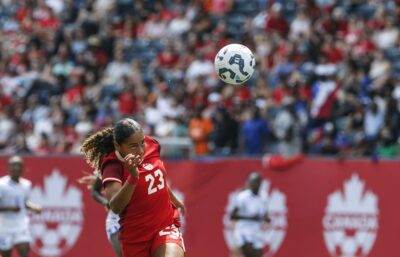Arsenal’s gaudy transfer fee for Canadian forward Olivia Smith buzzes at home
By Canadian Press on July 17, 2025.

A Canadian player setting a new benchmark in the women’s soccer transfer market floats a lot of boats, says Northern Super League co-founder and former Canadian international Diana Matheson.
The one million pounds (C$1.85 million) Arsenal paid Liverpool for 20-year-old forward Olivia Smith of Whitby, Ont., in the Women’s Super League is the biggest price tag in women’s soccer history for a transfer.
Matheson says an accelerating transfer fee market bodes well for the NSL, which kicked off this year with six teams and a mission to provide the first domestic women’s pro league for Canadian and international players.
“The growth of the market really helps us sell to investors in Canada and abroad,” she said. “The transfer market is obviously a piece of that puzzle.
“This is where the market’s at that a Canadian player is going for this and how exciting is it like that we’re not far around the corner now that we have a professional league, that if top Canadians choose to leave the Canadian league in the future, clubs could be selling them for a whole lot of money because we create such world-class players.”
Smith’s transfer to the Gunners announced Thursday surpassed the previous high of 900,000 pounds (C$1.6 million) Chelsea paid the NWSL’s San Diego Wave for American centre back Naomi Girma in January.
“To be part of a movement that’s changing how the game is valued is an honour,” Smith said in a statement released by her public relations agency.
“This is a huge step forward for women’s soccer and for Canadian soccer. I hope this shows young Canadian girls that anything is possible.”
Matheson, who retired in 2021, says a transfer fee market for women was nonexistent for most of her career.
“The Olivia Smith transfer is an indication of the strength of the women’s soccer transfer market and the overall business model,” she said.
“We all know what transfer fee market looks like on the men’s side. And then the women’s side, this is a fairly newer revenue stream.
“How exciting is it that like we produce so many incredible players like Oliva, what a positive indicator for women’s soccer in Canada that we now have a league and these future players could be playing in Canada, and these giant transfer fees could actually be coming to Canadian clubs in the future and actually fuelling the growth of Canadian women’s soccer.”
The most expensive transfer fee on the men’s side was 200 million pounds (CDN $368 million) for Neymar’s move from Barcelona to Paris Saint-Germain in 2017. FIFA reported US$8.59 billion was spent on men’s transfers in 2024.
The women’s transfer market was small by comparison at $15.6 million, but was double the amount of 2023. Given the rapid expansion, Smith might not hold the record long.
“This is a touch point on the value of the marketplace when so many people are looking for data points and growth factors,” said Cheri Bradish, an associate professor and director of Future of Sport Lab and Sport Initiatives at Toronto Metropolitan University.
“It just really validates the growth and development of the women’s sports market.”
A Deloitte study predicted global revenues in women’s elite sports will reach at least US$2.35 billion (C$3.2 billion) in 2025, with women’s soccer accounting for 35 per cent behind basketball at 44.
Arsenal’s investment in Smith is interesting on multiple fronts, says Canadian Women and Sport chief executive officer Allison Sandmeyer-Graves.
“Just knowing that Olivia’s a Canadian, what a cool indicator of just the quality of Canadian talent,” she said.
“It’s about the calibre of the player already, but also for the player’s incredible potential going forward. They expect her star to continue rising and they expect that next time there’s a trade the figure is going to be even higher, but also that she is going to be a very productive player while she’s there with their team.
“We are talking wins and losses, but we’re also talking about commercial value. They obviously expect that her being in their club is going to be a driver of revenue and of value for their club.”
This report by The Canadian Press was first published June 17, 2025.
Donna Spencer, The Canadian Press
-25




